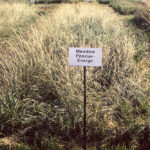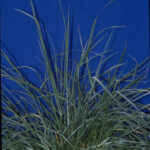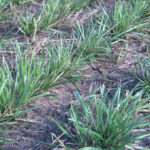Meadow Fescue
Lolium pratense
General Description
Meadow fescue is a perennial bunch grass suited to higher precipitation areas, but lacks longevity due to poorer winter hardiness and susceptibility to heavy grazing. It is very closely related to tall fescue, and can be hard to distinguish. Generally, meadow fescue is less persistent, shorter, and finer leaved. It has the ability to cross with perennial and annual ryegrass.
Stems grow up to 1 m (40 in) tall. Leaves are mostly basal, with blades that are flat, dark green and have veins running down them. The leaf undersides are glossy and the edges are rough. Seed heads develop with 6 to 10 flowers per spikelet. Meadow fescue is cross-pollinated (and can cross with grasses) and the seed shatters easily.
Type
Tame grass.
Origin
Europe.
Longevity
At least 5 years.
Use
Pasture, hay, stockpiled. Meadow fescue is best used as pasture as growth is mainly basal.
Optimal Time of Use
Spring, summer, fall, winter. Meadow fescue has been replaced mainly by new tall fescue varieties that have equal adaptability and more production and longevity. Hay by heading. Meadow fescue is best rotationally grazed but can be continually with care. Leave at least 10 cm (4 in) for regrowth to occur. Good for summer grazing or stockpiling for fall and early winter grazing as it maintains quality well after fall frosts.
Recovery After Use
Requires a minimum 45-60 days of recovery after use. If hayed, meadow fescue can be grazed or stockpiled thereafter.
Palatability/Nutritional Value
Meadow fescue has an average total digestible nutrient (TDN) level of 61% and crude protein level of 12.5% in the vegetative state. Meadow fescue has fair palatability. Meadow fescue remains green into the fall.
Annual Precipitation min/max (mm)
500mm minimum
Drought Tolerance
Moderate tolerance. It is less drought tolerant than tall fescue.
Flooding Tolerance
Withstands 2-5 weeks of spring flooding. It withstands wet soils season long.
Winter Hardiness
Fair hardiness. Meadow fescue longevity is limited by winter hardiness.
Soil Texture Preference
Meadow fescue is best suited to moist or wet clay-loam to clay soils, but will grow on light textured soils with high moisture. Moisture is meadow fescue’s limiting factor.
Erosion Control
Moderate erosion control. Can be used as an initial species in waterways or channels to prevent erosion as it does not impede water movement.
Salinity Tolerance
Moderate tolerance.
Acidity Tolerance
Moderate tolerance.
Alkalinity Tolerance
Low tolerance.
Seeds per kg
507,000 seeds/kg (230,000 seeds/lb)
Suggested Mixtures
Meadow fescue is compatible in mixes. Species include alsike clover, birdsfoot trefoil, timothy and bromegrasses.
Ease of Establishment
Meadow fescue seedlings can establish well in the first season when competition is managed. It is noted to winterkill easily during the establishment year.
Competitiveness
Meadow fescue has moderate competitive ability. Overall, its longevity is limited with cold winter conditions.
Management Considerations
Allow for adequate rest following defoliation. Cold hardiness is its major limitation making it a grass not frequently used in Western Canada. May serve well as a short rotation, good producing grass species for late season grazing.
Saskatchewan Dryland Forage Species Adaptation Tool, USDA, Manitoba Forage Adaptation and Comparison Guide, Alberta Forage Manual
Meadow fescue is adapted to warmer and more wetter areas of the Sub-Boreal Spruce, Interior Cedar-Hemlock and Sub-Boreal Pine-Spruce zones. In the southern part of the region, meadow fescue is adapted to the wetter areas of the Interior Douglas-fir zone, and to irrigated and subirrigated areas in the Bunchgrass and drier areas of the Interior Douglas-fir zone.
Meadow fescue is adapted to the wetter parts of the Interior Douglas-fir zone, the Interior Cedar-Hemlock zone, and to irrigated and subirrigated areas in the Bunchgrass and Ponderosa Pine zones, and Interior Douglas-fir zone.
Meadow fescue has some adaptive characteristics suited to the Peace-Liard region, but only fair hardiness is likely to limit its use.


